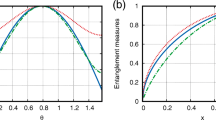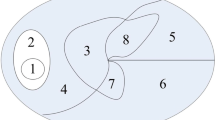Abstract
In the Hilbert space operator formalism of quantum mechanics, a single quantum state, which is represented by a density operator, can be regarded as classical in the sense that it can always be diagonalized. However, a quantum ensemble, which is represented by a family of quantum states together with a probability distribution specifying the probability of the occurrence of each state, cannot be diagonalized simultaneously in generic cases, and possesses intrinsic quantum features as long as the involved quantum states are not commutative. The natural question arises as how to quantify its quantumness. By virtue of a canonical correspondence between quantum ensembles and classical-quantum bipartite states, we propose an intuitive entropic quantity which captures certain quantum features of quantum ensembles, and compare it with that defined as the gap between the Holevo quantity and the accessible information. Implications for quantum cryptography and relations to quantum channel capacities are indicated. Some illustrative examples are worked out.
Similar content being viewed by others
References
Alicki R., Van Ryn N.: A simple test of quantumness for a single system. J. Phys. A 41, 062001 (2008)
Alicki R., Piani M., Van Ryn N.: Quantumness witnesses. J. Phys. A 41, 495303 (2008)
Holevo A.S.: Bounds for the quantity of information transmitted by a quantum communication channel. Problems Inform. Trans. 9, 177 (1973)
Davis E.B.: Information and quantum measurement. IEEE Trans. Inform. Theory IT 24, 596 (1978)
Peres A., Wootters W.K.: Optimal detection of quantum information. Phys. Rev. Lett. 66, 1119 (1991)
Jozsa R., Robb D., Wootters W.K.: Lower bound for accessible information in quantum mechanics. Phys. Rev. A 49, 668 (1994)
Hausladen P., Wootters W.K.: A “pretty-good” measurement for distinguishing quantum states. J. Mod. Opt. 41, 2385 (1994)
Fuchs, C.A.: Distinguishability and accessible information in quantum theory, arXiv:quant-ph/9601020 (1996)
Sasaki M., Barnett S.M., Jozsa R., Osaki M., Hirota O.: Accessible information and optimal strategies for real symmetrical quantum sources. Phys. Rev. A 59, 3325 (1999)
Fuchs, C.A.: Just two nonorthogonal quantum states, arXiv:quant-ph/9810032 (1998)
Fuchs, C.A., Sasaki, M.: The quantumness of a set of quantum states, arXiv:quant-ph/0302108 (2003)
Ollivier H., Zurek W.H.: Quantum discord: a measure of the quantumness of correlations. Phys. Rev. Lett. 88, 017901 (2002)
Henderson L., Vedral V.: Classical, quantum and total correlation. J. Phys. A 34, 6899 (2001)
Vedral V., Plenio M.B., Rippin M.A., Knight P.L.: Quantifying entanglement. Phys. Rev. Lett. 78, 2275 (1997)
Henderson L., Vedral V.: Information, relative entropy of entanglement, and irreversibility. Phys. Rev. Lett. 84, 2263 (2000)
Vedral V.: The role of relative entropy in quantum information theory. Rev. Mod. Phys. 74, 197 (2002)
Rajagopal A.K., Rendell R.W.: Separability and correlations in composite states based on entropy methods. Phys. Rev. A 66, 022104 (2002)
Usha Devi A.R., Rajagopal A.K.: Generalized information theoretic measure to discern the quantumness of correlations. Phys. Rev. Lett. 100, 140502 (2008)
Werner R.F.: Quantum states with Einstein-Podolsky-Rosen correlations admitting a hidden-variable model. Phys. Rev. A 40, 4277 (1989)
Nielsen M.A., Chuang I.L.: Quantum Computation and Quantum Information. Cambridge University Press, Cambridge (2000)
Horodecki M.: Entanglement measures. Quantum Inform. Comp. 1, 3 (2001)
Piani M., Horodecki P., Horodecki R.: No-local-broadcasting theorem for multipartite quantum correlations. Phys. Rev. Lett. 100, 090502 (2008)
Luo S.: Using measurement-induced disturbance to characterize correlations as classical or quantum. Phys. Rev. A 77, 022301 (2008)
Li N., Luo S.: Classical states versus separable states. Phys. Rev. A 78, 024303 (2008)
Ohya M., Petz D.: Quantum Entropy and Its Use. Springer, Berlin (1993)
Partovi M.H.: Correlative capacity of composite quantum states. Phys. Rev. Lett. 103, 230502 (2009)
Luo S.: Quantum discord for two-qubit systems. Phys. Rev. A 77, 042303 (2008)
Horodecki, M., Horodecki, P., Horodecki, R., Piani, M.: Quantumness of ensemble from no-broadcasting principle, arXiv:quant-ph/0506174 (2005)
Luo S., Li N., Cao X.: Relative entropy between quantum ensembles. Periodica Math.Hung. 59, 223 (2009)
Author information
Authors and Affiliations
Corresponding author
Rights and permissions
About this article
Cite this article
Luo, S., Li, N. & Sun, W. How quantum is a quantum ensemble?. Quantum Inf Process 9, 711–726 (2010). https://doi.org/10.1007/s11128-010-0162-5
Received:
Accepted:
Published:
Issue Date:
DOI: https://doi.org/10.1007/s11128-010-0162-5




